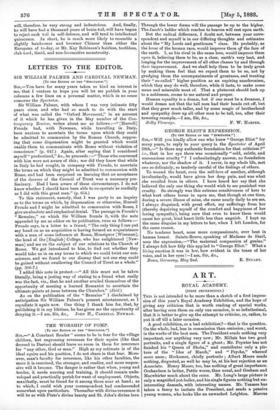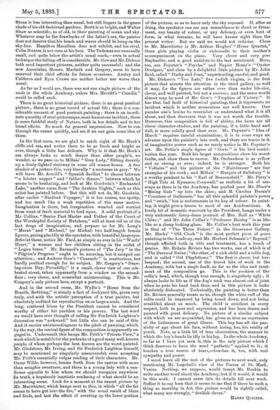ART.
ROYAL ACADEMY.
(FIRST IMPRESSIONS.)
THIS is not intended to be more than a sketch of a first impres- sion of this year's Royal Academy Exhibition, and the hope of giving any criticism that is worth reading of special works, after having seen them on only one occasion, is so infinitesimal, that it is better to give up the attempt to criticise, or, rather, to put it off till a later occasion.
A good exhibition, or a bad exhibition ?—that is the question. On the whole, bad, less in commission than omission ; and worst, in the works of the best men. The President sends nothing very important, nor anything very new; Mr. Millais has two good portraits, and a single figure of a ghost ; Mr. Poynter has not finished his "Queen of Sheba," and contributes only a pic- ture of the "Ides of March," and "Psyche," whereof more anon; Herkomer, chiefly portraits ; Albert Moore sands nothing, disgusted, as well he may be, at his last rejection as an Associate. Henry Moore, too, has nothing of great importance. Orchardson is better, Pettie worse, than usual, and Graham and Macwhirter much about the same. Mr. Long's large picture is only a magnified pot-boiler, and his single figures nothing but un- interesting damsels, with interesting names. Mr. Yeames has taken a fancy to imitate the President, and sends a pensive young woman, who looks like an unwashed Leighton. Marcus Stone is less interesting than usual, but still lingers in the green shade of his old-fashioned gardens. Brett is as bright, and Walter Shaw as scientific, as of old, in their painting of ocean and sky. Whatever may be the drawbacks of the latter's art, the painter does not deserve that his beach and waves should be hung on the -sky-line. Hamilton Macallum does not exhibit, and his rival, Colin Hunter, is not seen at his best. The Tademas are unusually small, and quite below the artist's usual mark,—even in actual technique the falling-off is considerable. Mr. Gow and Mr. Dicksee both send important pictures, neither quite successful; and the new Associates, Messrs. Macbeth and Gregory, seem to have reserved their chief efforts for future occasions. Anstey and -Calderon and Eyre Crowe are neither better nor worse than usual.
As far as I could see, there was not one single picture of the nude in the whole Academy, unless Mrs. Merritt's " Camilla " 'could be called such.
There is no great historical picture; there is no great poetical picture ; there is no great record of actual life ; there is a con- siderable amount of good portrait-painting ; there is an inordi- nate quantity of semi-picturesque, semi-humorous incident; there is some faithful study of Nature, both in her details and in her broad effects. So much for general impressions. Now to run through the rooms quickly, and see if we can gain some idea of them.
In the first room, we are glad to catch sight of Mr. Hook's .cliffs and sea, and notice them to be as fresh and bright as -ever, though a little less delicate. Why is it that Mr. Hook's sea always looks so much deeper than other people's, we wonder, as we pass on to Millais' "Grey Lady," flitting drearily .up a dimly-lighted stairway in some old manor-house. A fine shadow of a picture this, very literally " a nocturne in grey." We will leave Mr. Arnold's "Spanish duellist" to choose between a lobster supper" and "fathers dinner," between which he .seems to be hesitating, and look at Mr. Goodwin's "Enchanted Lake," another scene from "The Arabian Nights," such as this artist has painted before. But this will not do, Mr. Goodwin, after earlier " Sindbad Voyages ;" it is too coarse, too spotty, and too much like a weak repetition of the same motive. imagination is there, but imagination wearied and worried from want of fresh material to feed upon. A solid portrait of a Mr. Collins, "Senior Past Master and Father of the Court of the Worshipful Society of Butchers," will at least rid us of the last dregs of imagination, and prepare us for Mr. Long's
Merab " and "Michael," (or Michel) two half-length female ligures, gazing placidly at the spectator, with beautiful, large eyes. Betwixt these, notice Mr. Feed, as simple as ever in his " Waefu' -Heart," a woman and her children sitting in the midst of 4‘ Logan braes." Mr. Barnard's pictures of "The Jury" in the " Pilgrim's Progress" ought to be amusing, but it escaped our attention; and Andrew Gow's " Consuelo" is meritorions, but hardly poetical enough for its subject. Mr. Gregory's "Draw- ing-room Day, Piccadilly," is a small, clever view of our cele- brated street, taken apparently from a window on the second- floor ; very clever, and somewhat uninteresting. This is Mr. 'Gregory's only picture here, except a portrait.
And in the second room, Mr. Wyllie's "Home from the Brazils, Refitting," is simply a fact of dockyard life, given very truly, and with the artistic perception of a true painter, but .absolutely unfitted for reproduction on so large a scale. And the long, scattered frieze by the President cannot be considered worthy of either his position or his powers. The last word we would have ever thought of calling Sir Frederick Leighton's
"decoration was "awkward," but little else can be said of this. And it carries uninterestingness to the pitch of yawning, which, .by the way, the central figure of the composition is apparently en- gaged in. Underneath this hangs Mr. Frith's "Private View," a work which is notable for the portraits of a good many well-known people, of whom perhaps the best known are the worst painted. Mr. Gladstone, Mr. Irving, and Sir Frederick Leighton himself, enay be mentioned as singularly unsuccessful, even accepting Mr. Frith's essentially vulgar reading of their characters. Mr. Oscar Wilde, however, beams forth from the canvas with more
than seraphic sweetness, and there is a young lady with a sun-
flower opposite to him whom we should recognise anywhere. In truth, a hopelessly inartistic rendering of what should be an interesting scene. Look for a moment at the sunset picture by Mr. Macwhirter, which hangs next to this, in which "all the fat seems to have got into the fire," with the usual result of blaze and fizzle, and test the effect of covering up the lower portion
of the picture, so as to leave only the sky exposed. If, after BO doing, the spectator can see any resemblance to cloud or firma- ment, any beauty of colour, or any delicacy, or even hint of form, in what remains, he will have keener sight than the present writer. But we said we would not criticise. Close to Mr. Macwhirter is Mr. Arthur Hughes' "Home Quartet," three girls playing violin or violoncello to their mother's accompaniment on the piano. Very clever and very pre- Raphaelite, and a good antidote to the last mentioned. Here, too, are Poynter's "Psyche," and Napier Hemy's "Oyster Dredgers," and close by a delightful little picture by Mr. John Reid, called "Darby and Joan," unpretending, careful, and good.
Mr. Dicksee's "Too Late," five foolish virgins, is the first picture that arrests the attention in the third gallery, as well it may, for the figures are rather over than under life-size, clever, and, well painted, but not a success ; and the same words almost may be used of Mr. Gow's "Trophies of Victory." It has that bad fault of historical painting, that it represents an incident which is neither momentous nor well known. One puzzles one's brains to remember or understand what it is all about, and then discovers that it was not worth the trouble. However, this composition is full of ability, the faces are all clever character-studies, and the painting, if a little hard and dull, is more solidly good than ever. Mr. Poynter's "Ides of March" requires careful examination ; it is in some ways an advance upon the painter's late work, and there are traces in it of imaginative power such as we rarely notice in Mr. Poynter's art. Mr. Pettie's single figure of " Oaric " is his best contri- bution this year. Both his larger compositions show his worst faults, and show them to excess. Mr. Orchardson is as yellow and as strong as ever ; indeed, he is stronger. Both his " Voltaire " and his picture of the " Hairdresser " are fine examples of his work ; and Millais' "Marquis of Salisbury" is a worthy pendant to his "Earl of Beaconsfield." Mr. Percy's "High Tide at Kynance, Cornwall," as realistic a bit of sea- scape as there is in the Academy, has pushed poor Mr. Shaw's "Rising Gale" up into the skies ; and M. Carolus Duran's "Countess of Dalhousie," has all this splendid painter's powers and "swish," but is unfortunate in its key of colour. In paint- ing, it might give a lesson to most of our Academicians. A. lovely bit of domestic waxwork by the President, hangs under a very undomestic fancy-dress portrait of Mrs. Hall as "White China ;" and Mr. John Collier's "Professor Huxley" is as life- like as a cheap looking-glass. Mr. Collier's best work this year is that of "The Three Sisters" in the Grosvenor Gallery. Mr. Marks' "Old Clock" is the most perfect piece of genre painting in the Academy, and Mr. Herbert Schmalz's "Beyond," though affected both in title and treatment, has a touch of genius. Mr. Britain Riviere has two works, one of which is of 'The Drove of Swine ;" the other, of a sick child and a collie dog, and is called " Old Playfellows?' The first is clever, but bur- lesqued; the second, one of the truest bits of work in the Academy, with but a single fault, as far as the idea and treat- ment of the composition go. This is the position of the collie's head, which, though true enough, is singularly ugly ; it always looks in life as if the dog's neck was almost out of joint when he puts his head back thus, and in this picture it looks absolutely dislocated. Technically, the painting is better than Mr. Riviere generally. treats us to, though the white ruff of the collie could be improved by being toned down, and not being scrabbled about so much. The child is excellent in every respect, both in pose and expression, and has been drawn and. painted with great delicacy. No picture of a similar subject with which we are acquainted, has given so true an expression of the listlessness of great illness. This boy has all the pas- sivity of age about his face, without losing, too, his reality of youth. Note, as a little bit of true observation, the manner in which the boy's hands lie idly in his lap. In the whole Academy, so far as I have yet seen it, this is the only picture which I think deserves to have the word " pathetic " applied to it; it touches a true source of tears,—tonches it, too, with real sympathy and power.
I must leave all the rest of the pictures to next week, only mentioning Mr. Logsdall's view of the Piazza of St. Mark, Venice. Nothing, we suppose, would tempt Mr. Ruskin to write another word about the Academy, but if it would, it would. be this work. I cannot enter into its details till next week. Suffice it to say here that it seems to me that if there be such a thing as morality in Art, this picture would be rightly called, what many are wrongly, "devilish clever."
HA.RRY QUILTER.



































 Previous page
Previous page